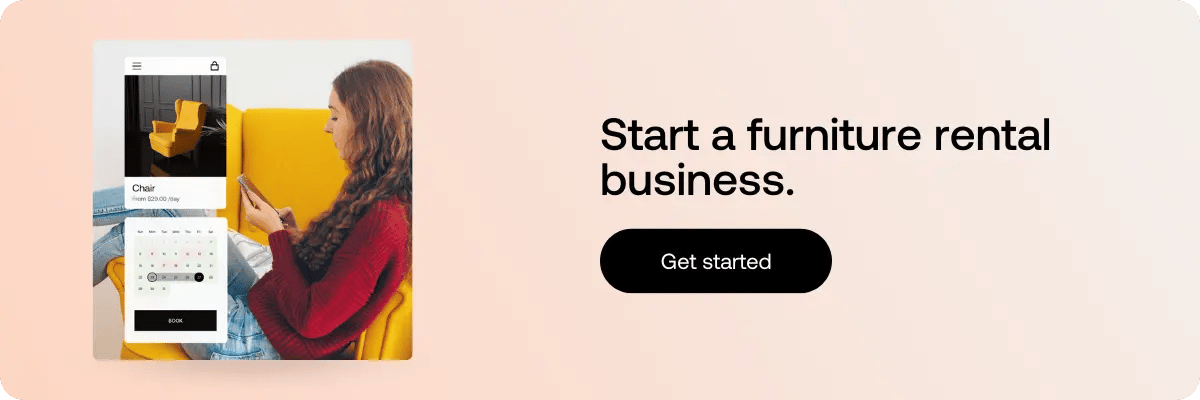In today's ever-changing landscape, the furniture rental industry is finding its footing among various customer needs. Exploring this growing market reveals numerous rental niches and models designed to accommodate both industrial and domestic clients. With options ranging from short-term leases for temporary use to long-term arrangements for more established requirements, the current environment presents a fitting opportunity for those considering the establishment of a furniture rental company.
The global furniture rental industry is currently worth about $52 billion. It has a predicted compound annual growth rate (CAGR) of around 7%. As businesses look to deepen their customer relationships and the importance of corporate responsibility themes continues to grow, more and more companies are exploring the product-as-a-service models. The furniture industry does not stand apart from this trend, which is why we are also seeing the proliferation of rental-based models in interior design.
Create a furniture rental business plan
All startup furniture leasing companies need a plan to turn the business idea into an actual business. That means doing lots of research on your market and competitors and strong financial planning.
Market research and competitor analysis
The furniture rental market serves lots of niches. Some of the different categories to consider are:
-
Office furniture rentals
-
Home furniture rentals
-
Outdoor furniture rentals
-
Event furniture rentals
While you can try to be a jack of all trades, it's best to commit to a niche and grow steadily. Each furniture rental niche targets a specific audience.
A big thing to consider is your location. Are there lots of students and young professionals? Do you live near a business hub? Does the climate allow people to spend a lot of time in their yards? Does your area have lots of live events?
Identify areas where there is rental furniture demand. Consider whether you will compete on service, price, or choice.
Look at other furniture rental businesses in your area. Find out what niches they serve, what they do well, and what areas they struggle with. This process can help you identify a gap in the market.
Budgeting and financial planning
Starting a furniture rental business involves several fixed and variable costs. Your inventory will be one of the biggest investments. Thankfully, quality furniture is durable and has a long life cycle. As a result, the investment generates a recurring stream of income over a long period of time, and regular maintenance is not particularly demanding.
Forecasting how much it will cost to set up your business really depends on what niche you plan to enter. Here's a breakdown of the typical expenses:
Fixed Costs:
-
Lease or purchase of a warehouse or showroom: This space is necessary for storing and/or displaying the products. The cost will depend on the location and size of the property.
-
Initial inventory purchase: Acquiring a range of furniture to meet customer demands, including various styles, materials, and sizes.
-
Transportation vehicle: You need a vehicle to deliver furniture to your customers.
-
Insurance: Coverage for property, inventory, and potential liability, protecting the business from unforeseen events.
-
Salaries: Hiring employees to handle operations, customer service, and sales, as well as any administrative staff needed to run the business effectively. In the beginning, it is probably unrealistic to assume that you can hire several employees. But it is a good idea to take future recruitment needs into account at an early stage.
-
Marketing and advertising: Building brand awareness through online and offline channels, including website development, digital marketing, print materials, and more.
-
Office and warehouse equipment: Computers, software, shelving, storage racks, and other essential items to maintain organization and efficiency.
-
Legal and accounting fees: Retaining professional services for legal matters, tax preparation, and financial consulting.
Variable Costs:
-
Transportation and delivery: The cost of delivering rented furniture to customers and picking it up after the rental period, including vehicle maintenance, fuel, and labor.
-
Inventory maintenance and replacement: Ongoing costs for cleaning, repairing, or replacing damaged or worn-out furniture pieces.
-
Utilities: Monthly expenses such as electricity, water, and internet for the warehouse or showroom.
-
Seasonal or temporary staff: Additional labor costs during peak seasons or for special events, as needed.
Keep in mind that these costs can vary greatly based on factors such as location, target market, and the size of the business. It's crucial to thoroughly research and plan for these expenses when starting a furniture rental company.
Other than calculating the costs, furniture rental startups need to consider their income streams as well. Accurate planning of the pricing strategy is an essential part of revenue modeling. One interesting and emerging business and pricing model is the subscription model, not least because it generates predictable income and is ideal for building close and long-lasting customer relationships.
Once you have all this information, you can begin to formulate your go-to-market strategy.
Establish a legal entity for your business
There are a few administrative tasks you need to take care of before starting your furniture rental startup.
Choose a name for your business
The name you choose for your furniture rental startup will depend on the niche you want to serve. If your target audience is corporate businesses, you'll need something professional. If the market you're going for is events, you should consider something related to that space.
The name is an important part of your company's identity, which is why you can be creative. However, keep in mind that without a strong brand, the name should also be descriptive of what your business does.
Form a business entity
If you want to conduct business legally, you'll need to think about how to structure your business. There are a few good options for furniture rental services.
Sole proprietorship: This structure is straightforward to set up with only a social security number. However, it doesn't offer liability protection in the event of lawsuits or debts. Additionally, you'll need to pay taxes on both your personal and business income.
Partnership: Partnerships have many similarities to sole proprietorships, but they are a good choice if you want to go into business with someone else. They have the same tax and liability drawbacks, plus you're liable for your partner's misconduct.
LLC: LLC, aka Limited Liability Company, protects your assets from liability or legal claims. What's more, it also provides pass-through taxation.
While they are a little more complex to set up, an LLC saves you on tax and protects your assets, like your home, in the event of debts or lawsuits.
Register for taxes
You'll also need to register for taxes. Some taxes you'll need to pay are federal, state, and, most likely, sales taxes.
Registiering is easy. Just contact the IRS, and you can get an Employee identification number (EIN). Once you've secured an EIN, you can set up a business bank account. If you're starting a furniture rental business outside the US, consult your local authorities for guidance.
Set up a business bank account
Setting up a business bank account is the best thing you can do for your furniture rental business. It will give you access to a company credit card, and perhaps more importantly, it will help you build up credit.
Starting a business is full of stresses and strains. Credit facilities can help your cash flow, letting you manage the peaks and throughs of running a new business.
Necessary permits and licenses
If you rent out items, you'll need to secure a Seller's license. These goods are subject to sales tax, so you'll need the license to collect and remit sales taxes on your income. Otherwise, depending on your country or state, you might also need a business license. Check your local government website or speak to a legal professional to ensure your complaint.
Buy furniture rental insurance
There are a few different types of insurance that you'll need depending on how you set up your business.
Business property insurance: To protect your inventory from damage or loss.
Commercial automobile insurance: You'll need this if you plan to deliver and collect your inventory
Workers comp: These policies cover your employees in the event of injury.
General liability insurance: An all-around insurance that protects you against claims of damage, injury, and medical bills.
Always shop around and compare the best deals. The differences might surprise you.
Furniture sourcing and inventory management
When you've got the business side sorted out, it's time to get some inventory.
Sourcing furniture and equipment
Buying in bulk means you can get discounted prices. Again, this really depends on your niche. You can shop around online or try to work with suppliers directly. The best advice is to start out small. For example, if you want to serve the office sector, get some tables and chairs first and expand once you close a few deals.
Keep things as lean as possible. You want to minimize spend on storage.
Tips for maintaining and organizing inventory
Sound inventory management is key to running a profitable rental business. You must be able to:
-
Know where your inventory is at all times
-
Have smooth collections and deliveries
-
Have accurate stock levels
-
Have the ability to track the use and condition of your inventory
Therefore, inventory management software is essential. For a deeper dive into the subject, read our article An introduction to rental inventory management.
Marketing and customer acquisition
Identifying the most effective marketing channels for the target audience
Choosing the best marketing channels depends on the niche you want to enter. Business-to-business (b2b) and business-to-consumer (b2b) marketing have slight differences.
If you want to target the corporate or office world, places like LinkedIn, tradeshows, and company directories are a good idea.
However, if your aim is for consumers, then channels like social media and lifestyle magazines help you reach your audience in a relevant and timely context.
Either way, you'll need a solid website that showcases your goods and lets you accept online payments. On top of that, you need good local SEO strategies.
Creating a brand and messaging that resonates with your audience
Again, your audience will largely dictate your brand and messaging. There is a growing trend towards furniture rental as a convenience-driven and environmentally sound option. So that could form a big part of your offer. Otherwise, it depends on what you are competing on. If you've seen a gap in the market for no-frills, reliable, cost-effective furniture, then down-to-earth, simple messaging will be the best choice.
Tips for building a loyal customer base
Customer acquisition costs are high. If you want your business to flourish, you'll need a repeat, loyal customer base. However, it must be earned. Running a solid, transparent business is a start. Finding ways to offer value is the best way to build loyalty. You can do that through excellent service, competitive prices, or a wide variety of inventory.
Operations and Growth Strategies
Once your business is up and running, you need to stay vigilant and find ways to optimize your offers.
Best practices for managing daily operations and logistics
Running a furniture rental business involves moving inventory from place to place. Of course, you can run a storefront where people collect. However, in most cases, the expectation will be on you to provide delivery and collection as part of your service.
As we mentioned earlier, good rental inventory management software will help smooth your operations. Otherwise, planning your delivery and collection schedule with precision will ensure you meet customer expectations.
Finally, inspect each item that is returned to you for damage. Have a process that ensures repairs are performed swiftly so the items can return to your inventory. Additionally, implement scheduled audits of your inventory to ensure it's up to scratch.
Rental Contracts and Policies
Furniture rental providers need rock-solid contracts and policies. Your inventory is an investment, so you need to protect it from damage and loss. Both long and short-term rentals must have a facility to claw back money in the event of damage. Obviously, wear and tear is going to happen, but misuse on the part of the rentee should carry some penalty.
Some of the elements of your contracts and policies should include:
-
Service level agreement (SLA): A clear setting out of expectations for what the customer should expect from your business will help avoid disputes.
-
Cancellation policy: Short notice cancellation can leave you out of pocket. Protect yourself with a no or partial refund policy for 24 or 48-hour cancellations.
-
Liability waiver: A liability waiver for damages or loss that occur due to your products is important too. If your furniture goes out in good condition, you shouldn't be held responsible for accidents.
Strategies for scaling the business and increasing revenue
Many furniture rental providers branch out into areas that are adjacent to their niche.
AV equipment: If you serve the event and party rental niche, you can start offering speakers, screens, PA systems, and so on. Party organizers are often under stress, which is why they hope to get everything under one roof.
Assembly: Some furniture needs to be assembled and disassembled. Offering this as part of your service can provide a new revenue source.
Furniture subscriptions: Furniture are a perfect example of a product that could be sold on a subscription basis. Especially for customers, such as students or expats, for whom the current living situation is temporary, buying furniture can be unattractive. A subscription-based interior design service provides the flexibility needed to cope with changing life situations.
Find collaborations: Look for collaborations that can turn into long-term projects. For example, real estate staging, the film industry, or photographers need props and background furniture.
Extras: While tables, chairs, and couches will make up the bulk of your sales, things like artificial plants, artwork, TVs, and other household items could become part of your service.
Conclusion
Starting a furniture rental business is a great way to get on top of a growing trend. The best thing to do is pick a specific furniture rental niche and work to grow connections and your reputation.
The overall furniture rental industry is very healthy right now. Alongside traditional markets like events and offices, consumers are shifting towards a product-as-a-service model. People want to rent and not own, which offers a big opportunity for new businesses.










